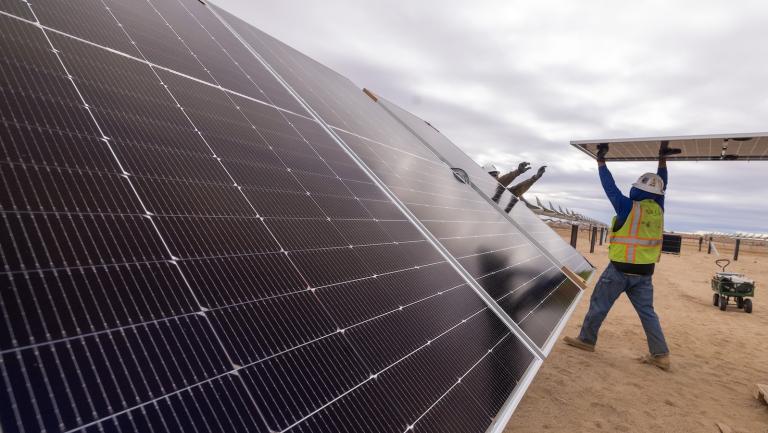
The vision
“There’s our carbon footprint to think about, and then there’s also our cultural footprint — both of which are important, but this industry is uniquely positioned to have a large cultural footprint.”
— Sam Read, executive director of the Sustainable Entertainment Alliance
The spotlight
Dearest gentle reader,
One thing about me is that I love a good (or medium-good, or downright trashy) TV show. Last summer, we covered the rise of climate mentions and plotlines in mainstream movies and shows — something I had begun to witness as a casual viewer.
But recently, I’ve also been thinking about the fact that the shows I binge so voraciously come with their own carbon footprint, much like any other product that we consume. Producing a piece of media requires energy, transportation, filming and audio equipment, food, wardrobes, props, and a host of other resources.
Just as film creators and studios are increasingly considering how to weave climate narratives into their projects, the industry is also grappling with the challenge of decarbonizing behind the scenes.
“The biggest source of emissions for our industry, at least in terms of production, is fuel,” said Sam Read, executive director of the Sustainable Entertainment Alliance. That includes not only vehicles that bring equipment, catering, and people to set, but also a source you might not immediately think of: diesel generators. TV and film productions often shoot on location, including in remote areas, and rely on a setup of trailers. Diesel-powered generators have long been the industry standard for supplying power to these sets. And diesel is a particularly dirty fuel, causing air pollution with a range of known health effects.
The Sustainable Entertainment Alliance (formerly the Sustainable Production Alliance), a coalition of leading studios and streamers working toward sustainability in the industry, offers tools like a carbon calculator for productions and a checklist for implementing sustainable practices — such as donating uneaten craft services food, using responsibly sourced plywood to build sets, or buying used items for set decoration.
And a big one is swapping out those old diesel generators for a variety of cleaner alternatives, including hydrogen and solar power, which a few recent productions have started to make use of.
In many cases, the switch to greener practices isn’t just about helping the climate. These modern technologies are also healthier and more efficient. “There are so many benefits to the alternatives to diesel generators — one of them obviously being emissions — but they’re also quieter and less polluting,” Read said. For that reason, they can be situated closer to “video village” (where the director sits on a film set, observing the action from various monitors), eliminating some of the need for long cables.
The alliance, which already includes major players like Disney, Amazon Studios, Netflix, and Paramount Pictures, is working to broaden its membership. Read sees a growing appetite for decarbonization in the entertainment industry, driven in part by advocacy from unions like The Producers Guild of America, which helped create the sustainable production checklist. (Check out the 2022 Hollywood Reporter report on sustainability for more stories of how studios have embedded climate goals into productions.)
The alliance and other groups are also advocating for more climate stories onscreen. But in another part of the industry, the distinction between what happens behind the scenes and on camera is a little fuzzier, creating unique opportunities to both decarbonize and model sustainability to viewers. That’s reality TV — my truest and guiltiest pleasure.
“It is such a good year for sustainability on TV,” said Cyle Zezo, an executive producer and the founder of Reality of Change, an initiative focused on sustainability and climate storytelling opportunities in unscripted entertainment, including documentaries, reality TV, and game and competition shows.
On average, Zezo said, the footprint of an unscripted show is likely to be smaller than a scripted production. Producers of these shows may contend with some of the same issues — like the need for clean energy to power equipment in remote filming locations. But generally, the clean production practices on a reality show or documentary are simply reflecting the way real people live their lives.
When we spoke for my story last year, for instance, Zezo highlighted compost bins on the set of a cooking show called Recipe for Disaster, and how the crew intentionally showed them during filming. Also last year, Netflix announced a partnership with General Motors to use more electric vehicles in shows like Love Is Blind and Queer Eye.
“I’m gonna make a prediction, and I hope I’m right, that climate and sustainability representations are only going to continue to grow in this area over the coming years,” Zezo said.
I asked Zezo, Read, and others to point me toward some recent shows and movies that have embedded sustainability into their productions in new or interesting ways. These series and movies may not all appear to be climate-related, but they can all help decarbonize your summer watch list.
![]()
Clean power on set
Bridgerton. That’s right, dear readers. This steamy romance series set in the Regency era in London took a more modern approach to sustainability in the production of its third season. In a set tour, two actors from the show describe how the cast trailers and work trucks were all powered by a hydrogen power unit supplied by British company GeoPura. The production also omitted beef from craft services due to its outsized carbon footprint.
The Decameron. This upcoming show (premiering July 25), loosely inspired by the short story collection of the same name, tells the story of a debaucherous retreat in the Italian countryside as wealthy nobles, and their servants, attempt to avoid the bubonic plague. This show also pursued clean energy in its production; its base camp ran on batteries charged by solar panels, according to Netflix.
Bosch: Legacy. A third show replacing diesel generators on set, this is the next chapter of a seven-season police procedural drama following the career of detective Harry Bosch. The show was among the first to use mobile battery units designed by a company called Moxion.
Sitting in Bars With Cake. This 2023 movie, starring Yara Shahidi, Odessa A’zion, and Bette Midler, is about friendship, navigating life in your 20s, and, as the title would suggest, cake. It also used Moxion’s mobile clean-tech batteries on set.
The Gilded Age. In the second season of this historical drama, producers took a more holistic approach to get the show off diesel power. “They actually installed power lines — like they put in power poles and a whole power system in the backlot area where they were shooting,” Heidi Kindberg, the vice president of sustainability at Warner Bros. Discovery, told The Hollywood Reporter. That enabled the show to go generator-free when shooting its second season in New York.
True Detective: Night Country. The fourth season of this critically acclaimed crime drama takes place in the Arctic — it was filmed in Iceland, where the production was able to draw on the country’s nearly 100-percent renewable energy grid. Where remote power was needed, the show piloted an electric battery generator called the Benerator. According to a report from the Producers Guild of America, the show’s creators also slashed waste by placing recycling and compost bins and water-fill stations around set. And, this season features a climate-related storyline.
Subtle solutions on screen
Homegrown. In this series, now in its fourth season, Atlanta-based farmer and food activist Jamila Norman helps homeowners transform their yards into urban farms, while discussing the many benefits that farms and gardens can bring to communities. Zezo loves how it invites viewers in, showing them how anyone can do the things shown onscreen.
Building Outside the Lines. This quirky build show follows father-daughter duo Jared (“Cappie”) and Alex Capp as they take on bespoke design and construction projects, largely in their South Dakota community. Zezo noted that its sustainability themes are subtle, showcasing the use of electric power tools and unconventional or upcycled materials, like shipping containers.
OMG Fashun. This competition show, co-hosted by Julia Fox and Law Roche, is all about upcycled fashion — it’s Project Runway meets Chopped. The show is incredibly on-message with its themes of sustainability and reuse, Zezo said, without coming across as stuffy or preachy. “It’s just so sharp and creative and, like, absolutely wild fun.”
Family Switch. OK, this is a holiday movie — so maybe save it for a few months (or for a night when you just need something cozy). It’s a Freaky Friday-inspired family romp starring Jennifer Garner and Ed Helms, and according to Netflix it ran on electric vehicles. Four EV passenger vans transported the crew, another brought the catering and production items, and an electric pickup truck pulled the director’s trailer. An EV makes an onscreen appearance as well — it’s brief, but the family’s Polestar 2 shows up in at least one scene.
— Claire Elise Thompson
A parting shot
In March, the advocacy group Gas Leaks Project launched an awareness campaign about the health dangers of gas stoves — in the form of a reality TV show trailer. The made-up show was dubbed Hot & Toxic, a spoofy take on a house-full-of-hot-and-melodromatic-young-singles style of show, where the house is that of a new and unsuspecting homeowner, and the singles are personified forms of the cancer-causing chemicals spewing out of her stove.




